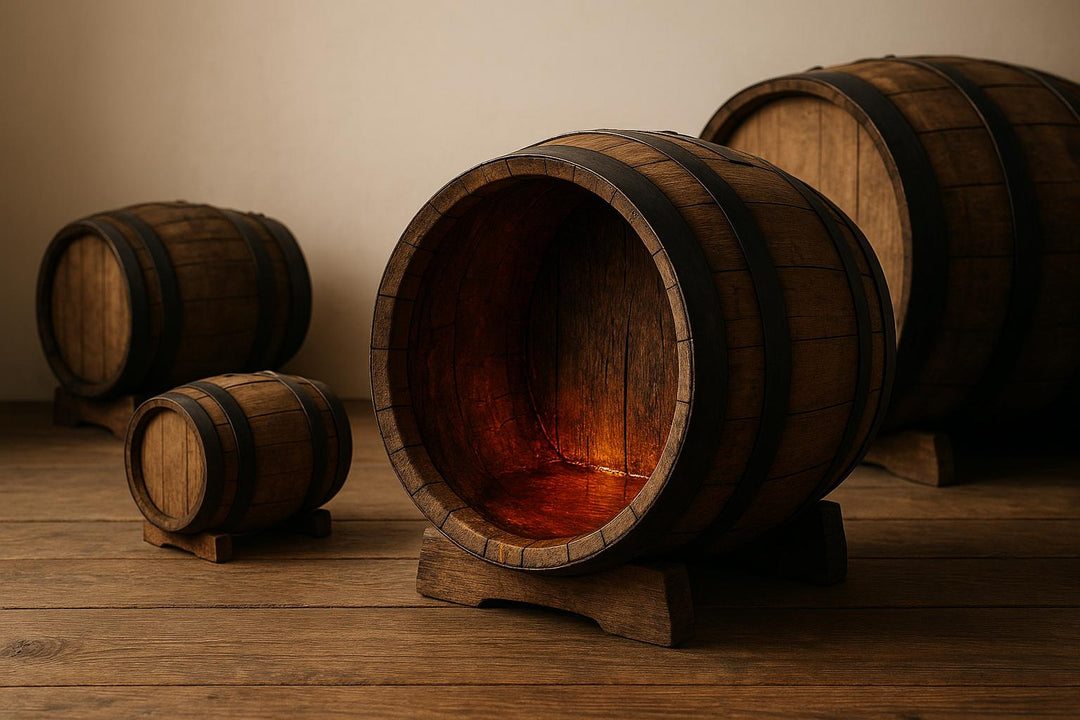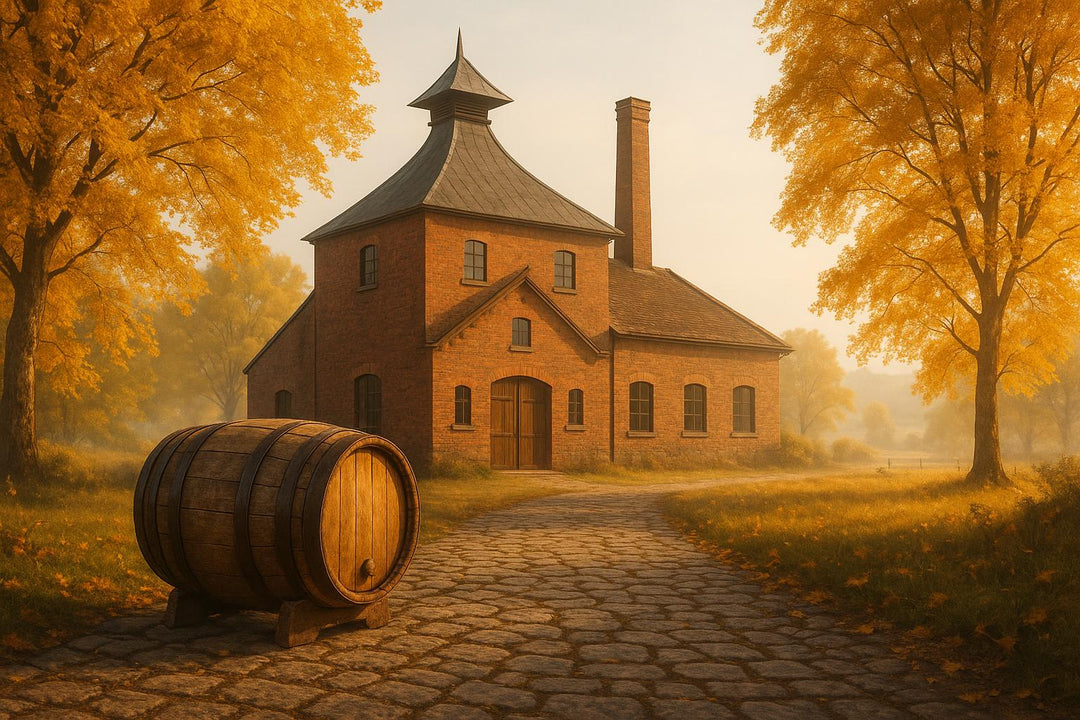In 2025, the whisky market is thriving, with changing consumer preferences and a growing focus on premium and rare whiskies. Valued at £53 billion in 2023, global whisky sales are projected to surpass £70 billion by 2032. Here's what you need to know:
- Premiumisation: Consumers are spending more on high-quality bottles while buying fewer overall. Younger generations are driving demand for luxury and experiential purchases.
- Market Shifts: Scotch whisky exports faced challenges in 2024, with single malt values dropping 17%, while blended Scotch grew by 4.4%. India is emerging as a key market, while China has seen a decline.
- Trends: Rare whiskies, cask finishes, and world whiskies from emerging regions are gaining attention. Technology like blockchain and whisky tokenisation is reshaping collecting and investment.
- Collection Strategies: Diversification across regions, styles, and price points is key. Balancing rare investment-grade bottles with accessible options ensures both enjoyment and financial potential.
- Practical Tips: Proper storage, documentation, and insurance protect collection value. Tasting packs and bespoke services offer tailored opportunities for collectors.
With whisky collections outperforming gold and stocks since 2019, it's an exciting time for collectors to blend personal taste with market insight.
Fah Mai's Jacob Carter talks 2024 trends and 2025 predictions

Current Whisky Market Data and Consumer Preferences
The whisky market in 2025 paints a picture of changing consumer habits and shifting regional trends. Global whisky sales are projected to climb from $118.5 billion in 2025 to $345.7 billion by 2035, reflecting a compound annual growth rate (CAGR) of 11.3% [1]. However, this growth isn’t uniform across the board. A clear trend of "premiumisation" has emerged, with buyers spending more on individual bottles but purchasing fewer overall [8].
Consumers are shifting their focus toward quality over quantity, favouring high-end expressions. This has caused a decline in the standard-and-below American whisky categories, while the super-premium-and-above segments have grown by roughly 6% [6].
Key Market Trends in 2025
The whisky market in 2024–2025 presents a mixed landscape, particularly for collectors. Scotch whisky exports dropped in value by 3.7% to £5.4 billion in 2024, despite a 3.9% increase in volume [3]. Single malt Scotch faced significant challenges, with export values plunging 17%, making up just 31% of total Scotch exports. On the other hand, blended Scotch showed resilience, growing 4.4% in value and accounting for 59% of total exports [3].
American whisky is facing an even tougher situation. For the first time in over two decades, sales declined in 2023, and that downward trend extended into 2024 [7]. The Distilled Spirits Council of the U.S. (DISCUS) described the scenario as "the worst-case" for the industry [3].
In response to these challenges, distilleries are turning to innovation. Experimenting with cask finishes and blends has become a standard strategy to stand out in a competitive market [6]. At the same time, transparency is becoming a key consumer demand, with buyers looking for more information about sourcing and production processes [6].
These trends vary widely depending on the region and style of whisky.
Consumer Preferences by Region and Style
Consumer habits in 2025 reveal some striking regional differences. India has emerged as a major player, importing 85 million 70cl bottles of Scotch between January and June 2024 [6]. Scotch exports to India also saw a nearly 14% increase in value [3]. In contrast, China experienced a sharp decline, with exports dropping by 31.5% in value [3], reflecting broader economic challenges and shifting tastes.
Closer to home, the United Kingdom is showing strong growth potential, with whisky sales expected to grow at a CAGR of 15.3% [1]. The United States follows closely with a CAGR of 12.7%, driven by the craft spirits boom and renewed interest in bourbon and rye [1]. Meanwhile, China’s market is expanding at a CAGR of 13.8%, with India leading the charge at 14.9% [1].
When it comes to whisky styles, consumer preferences have evolved significantly. Interest in cask finishes is growing, with enthusiasts eager to learn about the barrels used in maturation. Traditional favourites like port pipes and sherry butts continue to be popular, but rum casks are gaining attention [9]. Flavoured whisky is also making waves, with the category projected to reach $47.1 billion by 2030 [5]. Its rising popularity in cocktail-focused settings highlights its appeal [1].
Beyond these regional and style-based preferences, niche expressions are reshaping the whisky landscape.
Growth of Niche and World Whiskies
One of the most dynamic shifts in the market is the rise of niche and world whiskies. More consumers are seeking a sense of authenticity and a connection to tradition, driving interest in whiskies from lesser-known regions [12]. This trend reflects a move away from mass-market brands toward artisanal methods and distinctive flavour profiles.
Craft distilleries are at the forefront of this change, offering unique takes on whisky-making that resonate with adventurous drinkers [11]. The global whisky market, valued at approximately $69.24 billion in 2023, is forecast to grow to $100.34 billion by 2032, with a CAGR of 4.2% [11].
Interestingly, this growth isn’t confined to established markets. Emily Neill, Chief Operating Officer of Research and Operations at IWSR, observed:
"The drinks industry faces a subdued but opportunity-rich environment in 2025" [10].
Her insight highlights how emerging markets for alcoholic beverages are expected to drive significant growth over the next five years. Additionally, the trend toward more casual drinking occasions has provided a boost for niche producers, as consumers are more willing to experiment with lesser-known brands and styles [10].
Building a Balanced Whisky Collection
Whisky collecting is an art that blends personal passion with the potential for financial growth. Since 2019, whisky collections have outperformed gold and stocks, with an impressive average annual growth rate of 12.84% [17]. However, the 50% drop in auction values in Q2 2024 [15] highlights the importance of a well-thought-out, diversified approach. A balanced collection should reflect market trends while staying true to your individual taste.
Diversifying Across Regions and Styles
A well-rounded whisky collection goes beyond the familiar territories of Scotland and Kentucky. For instance, American single malt is currently the fastest-growing whisky category in the U.S. [13], and English whisky production has seen a staggering 189% growth from 2019 to 2023 [13]. These emerging markets offer exciting opportunities to acquire distinctive bottles before they become mainstream.
Scottish single malts remain a cornerstone of any collection, but consider exploring American single malts, particularly from the Pacific Northwest, where distilleries focus on local ingredients. English whisky producers are also making waves by combining traditional methods with new environmental conditions. For something truly distinctive, you could look to New World whiskies from countries like Bolivia, Sweden, or South Africa, which offer unique flavour profiles [13].
Style diversity is equally important. While blended whisky continues to dominate the global market with a 70.2% revenue share in 2024 [23], modern blends are pushing boundaries with cross-border collaborations and experimental cask finishes [20]. Single grain Scotch, often overlooked, provides a more affordable way to enjoy older expressions while offering unique flavours [19].
The trend towards terroir-focused editions mirrors the wine industry's emphasis on regional character. Distilleries are increasingly using local and non-traditional grains to create whiskies that reflect their environment [13]. For example, American Southwest distilleries produce mesquite-smoked single malts, while Midwest distilleries benefit from cold maturation conditions similar to Scotland [14].
Producers are also experimenting with innovative ageing techniques to reimagine classic styles [13]. This blend of regional and stylistic variety naturally leads to the next consideration: balancing rare finds with more accessible bottles.
Balancing Rare and Accessible Bottles
The whisky market is shifting towards affordability, with bottles under £1,000 now accounting for over half of transactions - a 43% increase from last year [15]. This trend makes it easier to build a strong foundation for your collection without requiring a huge financial outlay.
Start with well-known, widely available bottles that represent their regions. These accessible options not only provide enjoyment but also serve as a stepping stone while you research rarer additions. Premium bottles priced at £100 or more saw a 9% growth in 2023 [21], showing sustained interest in high-quality whiskies that don't necessarily break the bank.
When it comes to rare bottles, provenance and market position are key. Independent bottlers often offer unique cask finishes and experimental maturations at more reasonable prices than distillery-exclusive releases [19]. Limited editions and single-cask releases bring exclusivity, but it's crucial to focus on those with clear provenance [15].
Striking the right balance between collecting and drinking is essential. While rare whiskies have delivered a 280% return over the past decade [22], the primary goal of any collection should be personal enjoyment and education, with investment potential as a bonus.
Maintaining Collection Value
Proper storage and documentation are vital for preserving the quality and value of your collection. Store bottles upright in a cool, dark place, away from sunlight and temperature fluctuations [15]. To minimise air exposure, transfer whisky into smaller bottles once the original bottle is less than a third full [18]. Keep an up-to-date inventory with purchase details, market values, and tasting notes for insurance and tracking purposes [15].
As your collection grows, insurance becomes increasingly important. Alexandra Richards, private client development executive at Bruce Stevenson Insurance Brokers, advises:
"Insurance is there to put you back in the same financial position that you were in immediately prior to an insured event happening, such as a loss" [16].
She recommends agreed value policies:
"Agreed value allows you to set the value of the item in advance of a claim, and thus negates the chance of any argument around the value of the item after it has been lost" [16].
Ensure your inventory and valuation records are backed up off-site [16]. Insurers also expect you to take reasonable steps to protect and maintain your collection [16].
Staying informed about market trends is another way to maintain your collection's relevance. The global whisky market is projected to reach £89.1 billion by 2033, with an annual growth rate of 5.06% between 2025 and 2033 [15]. However, regional trends can vary - Scotch whisky exports, for example, dropped by 18% in the first half of 2024 [22], while markets like India are showing increased demand for premium whiskies.
Regularly reviewing your collection allows you to adapt to changing tastes and market conditions. Trading bottles that no longer align with your goals for ones that better suit your evolving preferences or investment strategy can keep your collection dynamic and rewarding.
Practical Methods for Expert Curation
Creating a standout whisky collection takes more than just picking up bottles on a whim. The best collectors adopt a thoughtful, strategic approach - one that allows them to discover exciting new flavours, tailor their collections to their tastes, and stay ahead of market trends. With the global whisky market expected to hit £83 billion by 2032 [28], there’s never been a better time to refine your curation methods, whether for personal enjoyment or long-term investment.
Discovering New Profiles with Tasting Packs
Tasting packs are an excellent way to explore the world of whisky without committing to full-sized bottles. These curated sets allow you to sample a variety of flavours side by side, helping you pinpoint what you enjoy most and identify any gaps in your collection [24]. Instead of spending a fortune on a bottle that doesn’t suit your palate, a tasting pack offers a smarter, more cost-effective alternative.
Prices for tasting sets range from around £14.24 to €180.50, depending on the selection and quality [24][25][26][27]. Many of these packs come with added perks like tasting notes or links to educational videos. As The Really Good Whisky Company explains:
"Each one of our luxury whisky gift sets come with tasting notes to guide you through the tasting experience and describe every unique element and complexity contained in each dram of our miniature whiskies" [25].
To make the most of your tastings, consider focusing on specific themes. Region-based packs, for example, highlight the influence of terroir, while style-specific sets let you dive into single malts, grains, or blends. Distillery-themed packs can reveal how factors like cask types and ageing impact the final product. Pairing these tastings with educational courses can deepen your understanding of whisky production and flavour development, laying the groundwork for more deliberate collection choices [24].
Customising Collections with Bespoke Services
Once you’ve explored different profiles, personalisation becomes the next step. The rising demand for tailored experiences [1] has led to the growth of bespoke services that allow collectors to add unique, meaningful pieces to their collections. From custom bottling to personalised labels, these options let you create something that’s truly one of a kind.
For instance, bespoke bottling enables you to select casks or blends that align perfectly with your taste. Custom labels, meanwhile, can transform bottles into memorable keepsakes - ideal for marking family milestones, celebrating business achievements, or crafting themed collections. Even corporate gifting has embraced these personalised touches, combining them with immersive tasting experiences to leave a lasting impression [1].
Updating Collections as Trends Change
Keeping your collection relevant means staying in tune with the ever-changing whisky market. Regularly reviewing your collection helps ensure it reflects both your evolving tastes and current trends. Ben Odgers, founder of Spirits Sourcery, highlights the importance of market awareness:
"The good news is the people who are most savvy about the market are the ones who remain. They know the niches within a niche, where value can be found, and where appreciation is still happening" [30].
Tracking whisky auctions, industry reports, and collector forums can reveal emerging opportunities and risks [31]. Younger generations, like Millennials and Gen Z, are driving demand for premium whiskies, aged expressions, and unique cask releases [2]. Sustainability is also becoming a key consideration, with distilleries adopting greener practices [2]. Meanwhile, technological advancements - such as AI-driven personalisation and whisky tokenisation - are reshaping the landscape [2].
It’s also worth exploring whiskies from less traditional regions, as these are gaining recognition [2]. Flavoured whiskies, too, are experiencing a surge in popularity, with the market projected to reach £86 billion by 2032 [29]. Regular audits of your collection can help you spot bottles that no longer align with your goals or the latest trends. As Odgers notes:
"For those with the money, patience, and strength of character, there has never been a better time to buy investment-grade bottles" [30].
To safeguard both the enjoyment and value of your collection, buy directly from distilleries or trusted retailers to ensure authenticity. Proper documentation is also crucial for protecting your investment [31]. For those looking to take their collection to the next level, consider bespoke cask programmes or exclusive access initiatives to secure rare, distinctive bottles [2].
sbb-itb-128d6c1
Collection Strategies for Different Palates
When it comes to whisky collecting, there’s no one-size-fits-all approach. Your strategy should align with your goals, budget, and personal taste. Some collectors prioritise geographical variety, others focus on financial potential, while many simply enjoy exploring unique flavour profiles. Understanding the pros and cons of each approach can help you decide which path suits you best.
Today’s whisky market celebrates global diversity like never before. Over 30 countries now produce whiskies that were once unimaginable [35]. From 2021 to 2022, the global whisky market grew by 8%, driven by innovation and the emergence of new styles and regions [35].
This shift in the market encourages collectors to adopt diverse strategies. Consumers are increasingly seeking variety, flavour, and choice, moving away from sticking to long-established flagship brands [32]. For collectors, this presents an opportunity to balance traditional favourites with contemporary expressions. Below, we’ll explore how different strategies align with these evolving trends.
Benefits and Drawbacks of Different Approaches
Each strategy offers unique advantages and challenges, often mirroring broader changes in the whisky market:
| Strategy | Benefits | Drawbacks |
|---|---|---|
| Region-Focused | Develops a deep understanding of local traditions and terroir; easier to specialise; strong cultural connections; potential for discovering hidden gems | Limited flavour variety; may overlook innovations from other regions; susceptible to regional market fluctuations |
| Style-Focused | Offers maximum flavour variety; appeals to diverse palates; great for entertaining; keeps the collection dynamic | Lacks geographical focus; harder to gain deep expertise; trends may fade; maintaining quality across styles can be challenging |
| Investment-Driven | Potential for financial returns; focuses on proven performers; creates valuable assets; access to exclusive releases | Requires significant initial investment; demands market knowledge; bottles may stay unopened; vulnerable to market downturns; less emphasis on personal enjoyment |
| Tasting Experience-Driven | Maximises enjoyment; encourages exploration; builds palate knowledge; highly flexible | May lack investment focus; harder to maintain collection value; frequent purchases required; can lead to impulsive buying |
For those drawn to specific whisky-making traditions, a region-focused approach can be particularly rewarding. For example, single malt Scotch whisky owes its distinct character to Scotland’s unique climate and geography [34].
On the other hand, a style-focused strategy opens the door to exciting possibilities. Andrew Fitzgerald highlights the freedom offered by New World whiskies:
"The beauty of the new world whisky landscape is its ability to allow more freedom of expression. We're OK with being outside the pocket of what to expect flavour-wise." [35]
Flavoured whiskies represent another growing segment. Between 2019 and 2023, their volume grew by 34%, now accounting for 24% of total whisky sales, up from 20% in 2019 [32]. This trend is set to continue, with the flavoured whisky market projected to reach USD 63.55 billion by 2035 [4].
For investment-focused collectors, the premium whisky market is expected to grow at a 4% compound annual rate until 2027 [35]. However, balancing financial goals with personal enjoyment is key to making this approach sustainable.
Meanwhile, contemporary whiskies with experimental finishes are gaining traction among judges and consumers alike [33]. These innovations allow collectors to embrace creativity while staying relevant in a competitive market [33].
Combining Strategies for a Balanced Collection
Many collectors find success by blending elements from multiple strategies. For instance, you might primarily focus on Scotch whisky but also include innovative expressions from other regions. Alternatively, an investment-driven approach could be complemented by affordable bottles for everyday enjoyment.
Geographical diversity is becoming increasingly important, even for collectors focused on specific styles. Regional and flavour preferences are being tailored to suit local palates around the world [4]. This trend highlights the growing importance of exploring whiskies from various parts of the globe.
If you’re new to collecting, a tasting experience-driven approach is a great way to discover your preferences before committing to a more focused strategy. Seasoned collectors, on the other hand, might combine high-value investment bottles with experimental releases to strike a balance between security and excitement.
Ultimately, the best collections reflect their owners’ personalities while embracing new discoveries and market trends. Keep your drinking habits, storage space, and budget in mind when choosing your strategy, and remember that your approach can evolve as your knowledge and circumstances change. A successful collection is both personal and adaptable, offering endless opportunities for exploration.
Key Points for Whisky Collectors
The global whisky market has seen remarkable growth, reaching an estimated £66.4 billion in 2024, with projections suggesting it could climb to £90.3 billion by 2030 [23]. For whisky collectors, this expanding market offers a mix of opportunities and challenges, especially for those aiming to build collections that combine personal enjoyment with long-term value. These trends align with the strategies discussed earlier.
Understanding market trends is essential for successful collecting. For instance, the growing preference for premium and craft whiskies highlights a shift towards quality over quantity [36]. This is particularly advantageous for collectors focusing on rare and exceptional bottles. Japanese whisky is a prime example of this trend, with its market expected to grow by £689.8 million between 2024 and 2028, reflecting an 11.8% compound annual growth rate. A standout case is Yamazaki 18, whose price skyrocketed by 1,117% between 2012 and 2022 [37].
Diversifying your collection across regions, styles, and price points can enhance both its enjoyment and value. Scotland, Japan, America, and emerging whisky markets all offer exciting opportunities. Balancing rare investment-grade bottles with more accessible options ensures a collection that caters to both connoisseurship and everyday enjoyment. Additionally, the rising popularity of Irish whisky and premium bourbons provides fresh opportunities beyond the traditional focus on Scotch [38].
Expert curation also plays a crucial role in navigating the increasingly complex whisky market. Tasting packs, for example, are an excellent way to explore a variety of flavours before committing to full-sized bottles [39]. For more serious collectors, bespoke services and exclusive access programmes can be game-changers for securing rare releases. A notable example is Element Irish whisky, which uses an "open innovation" approach by collaborating with industry experts and enthusiasts to refine its offerings before launching new expressions [40].
Practical aspects of collecting are just as important as market knowledge. Referencing earlier discussions on maintaining collection value can help ensure your investments are well-protected.
Finally, staying informed about evolving trends like sustainability and AI integration is key to keeping your collection relevant. These developments are reshaping the whisky landscape, offering new ways to enhance both the enjoyment and financial potential of your collection. In the end, successful collecting is all about blending market insight with personal passion.
FAQs
How is the trend towards premiumisation shaping whisky buying habits and collections?
The whisky market is seeing a noticeable shift towards premiumisation, reshaping the way people buy and collect their favourite spirits. More and more enthusiasts are gravitating towards rare, aged, and limited-edition whiskies, driven by a growing appreciation for luxury and fine craftsmanship. This change is also influenced by evolving tastes and the rise in disposable income.
For collectors, this trend opens up exciting opportunities. By concentrating on premium whiskies - those with unique age statements or limited production runs - they can not only meet the growing demand for exclusivity but also potentially elevate the prestige and market value of their collections.
What are the best strategies for creating a well-rounded whisky collection that reflects current trends?
To create a whisky collection that stands out and stays relevant, focus on variety and quality. Aim for a mix that includes premium whiskies - think rare or well-aged bottles - alongside limited-edition releases and flavoured whiskies to reflect shifting consumer preferences. Adding whiskies from diverse regions like Scotland, Japan, and the United States can bring a global touch to your selection.
Pay attention to cask-aged options and keep track of market trends to ensure your collection remains appealing over time. You might also explore personalised touches, such as bespoke bottlings or custom labels, to give your collection a distinctive edge. Ultimately, a thoughtfully chosen collection should showcase your personal taste while staying in tune with the ever-changing whisky world.
How are technologies like blockchain and whisky tokenisation changing the way people collect and invest in whisky?
The Impact of Blockchain and Whisky Tokenisation on the Market
New technologies like blockchain and whisky tokenisation are transforming the whisky market by making it easier to own and invest, while also boosting transparency. Blockchain provides a secure way to track transactions, ensuring buyers and investors can trust the authenticity and history of their whisky assets.
Whisky tokenisation takes this a step further by introducing fractional ownership. This means collectors can invest in premium casks or bottles without having to buy them outright. By breaking down these high-value assets into smaller, tradeable shares, tokenisation not only makes the market more liquid but also invites a wider range of people to join the whisky investment world. Together, these advancements are changing the way whisky is bought, sold, and valued in the digital age.






Leave a comment